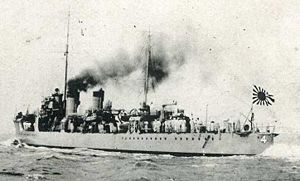Wakatake-class destroyer

The Wakatake-class destroyer Kuretake
|
|
| Class overview | |
|---|---|
| Name: | Wakatake class |
| Builders: | |
| Operators: |
|
| Preceded by: | Minekaze class |
| Succeeded by: | Kamikaze class |
| In commission: | 1920–1945 |
| Planned: | 23 |
| Completed: | 8 |
| Cancelled: | 15 |
| Lost: | 7 |
| Retired: | 1 |
| General characteristics | |
| Type: | Destroyer |
| Displacement: |
|
| Length: |
|
| Beam: | 7.9 m (26 ft) |
| Draught: | 2.5 m (8.2 ft) |
| Propulsion: | 2-shaft Mitsubishi-Parsons geared steam turbine, 3 heavy oil-fired boilers 21,500 ihp (16,000 kW) |
| Speed: | 36 knots (67 km/h) |
| Range: | 3,000 nmi (5,600 km) at 15 kn (28 km/h; 17 mph) |
| Complement: | 110 |
| Armament: |
|
The Wakatake-class destroyers (若竹型駆逐艦 Wakatakegata kuchikukan?) were a class of eight 2nd-class destroyers of the Imperial Japanese Navy.
The medium-sized Wakatake-class destroyers were a follow-on to the Momi class as part of the Imperial Japanese Navy's 8-6 Fleet Program from fiscal 1921 as a lower cost accompaniment to the larger Minekaze-class destroyers. The class was originally planned to consist of twenty-three vessels, but due to the Washington Naval Treaty, as well as budgetary limitations, the final number was reduced to eight. The Wakatake class was the last class to be rated "second class" and all future destroyers were designed larger. It was planned that the Wakatake-class ships should have names, but upon completion they were given numbers. This proved to be extremely unpopular with the crews and was a constant source of confusion in communications, so in 1928, names were assigned.
The Wakatake-class destroyers were essentially slightly modified Momi-class ships with a deeper draft to improve handling characteristics in heavy seas, particularly against rolling. Weaponry layout, general arrangement and silhouette were all identical with the Momi class.
As with the Momi class, a number of types of turbine engines were used for propulsion. Asagao was built with Parsons impulse turbines, Yūgao with Escher Wyss & Cie Zoelly turbines, and the remaining vessels with Brown-Curtis turbines.
...
Wikipedia
